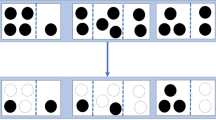Abstract
We introduce a class of impartial combinatorial games, Multi-player Last Nim with Passes, denoted by MLNim\(^{(s)}(N,n)\): there are N piles of counters which are linearly ordered. In turn, each of n players either removes any positive integer of counters from the last pile, or makes a choice ‘pass’. Once a ‘pass’ option is used, the total number s of passes decreases by 1. When all s passes are used, no player may ever ‘pass’ again. A pass option can be used at any time, up to the penultimate move, but cannot be used at the end of the game. The player who cannot make a move wins the game. The aim is to determine the game values of the positions of MLNim\(^{(s)}(N,n)\) for all integers \(N\ge 1\) and \(n\ge 3\) and \(s\ge 1\). For \(n>N+1\) or \(n=N+1\ge 3\), the game values are completely determined for any \(s\ge 1\). For \(3\le n\le N\), the game values are determined for infinitely many triplets (N, n, s). We also present a possible explanation why determining the game values becomes more complicated if \(n\le N\).
Similar content being viewed by others
References
Albert MH, Nowakowski RJ (2001) The game of End-Nim. Electr J Combin 8:Article R1
Albert MH, Nowakowski RJ (2004) Nim restrictions. Int Electron J Combin Number Theory 4:Article G01
Bouton CL (1901) Nim, a game with a complete mathematical theory. Ann Math 3:35–39
Cincotti A (2010) \(N\)-player partizan games. Theor Comput Sci 411:3224–3234
Flammenkamp A, Holshouser A, Reiter H (2003) Dynamic one-pile blocking Nim. Electr J Combin 10:Article N4
Fraenkel AS, Lorberbom M (1991) Nimhoff games. J Combin Theory Ser A 58:1–25
Friedman E (2000) Variants of Nim. Math Magic Game Arch. http://www2.stetson.edu/~efriedma/mathmagic/archivegame.html. Accessed Nov 2000
Guy RK, Nowakowski RJ (2009) Unsolved problems in combinatorial games. In: Games of no chance 3, Math. Sci. Res. Inst. Publ, vol 56. Cambridge Univ Press, Cambridge, pp 475–500
Holshouser A, Reiter H, Rudzinski J (2003) Dynamic one-pile Nim. Fibonacci Q 41(3):253–262
Kelly AR (2006) One-pile misère Nim for three or more players. Int J Math Math Sci 2006:1–8. https://doi.org/10.1155/IJMMS/2006/40796
Kelly AR (2011) Analysis of one pile misère Nim for two alliances. Rock Mt J Math 41(6):1895–1906
Krawec WO (2012) Analyzing \(n\)-player impartial games. Int J Game Theory 41:345–367
Krawec WO (2015) \(n\)-Player impartial combinatorial games with random players. Theor Comput Sci 569:1–12
Li SYR (1978) \(N\)-person Nim and \(n\)-person Moore’s Games. Int J Game Theory 7:31–36
Liu WA, Zhao X (2016) Nim with one or two dynamic restrictions. Discr Appl Math 198:48–64
Loeb DE (1996) Stable winning coalitions. In: Nowakowski RJ (ed) Proc MSRI workshop on combinatorial games, games of no chance 29:451–471. Cambridge University Press, Cambridge
Morrison RE, Friedman EJ, Landsberg AS (2012) Combinatorial games with a pass: a dynamical systems approach. arXiv:1204.3222
Low RM, Chan WH (2015) An atlas of N- and P-positions in ‘Nim with a pass’. Int Electron J Combin Number Theory 15:Article G02
Propp J (1996) Three-player impartial games. Theor Comput Sci 233:263–278
Straffin PD (1985) Three-person winner-take-all games with Mc-Carthys revenge rule. Coll J Math 16:386–394
Zhao X, Liu WA (2016) One pile misère bounded Nim with two alliances. Discr Appl Math 214:16–33
Acknowledgements
The authors are grateful to the responsible editor and the anonymous referees for their valuable comments and suggestions, which have greatly improved the earlier version of this paper. The research is supported by the National Natural Science Foundation of China under Grants 11171368 and 11171094. The research is also supported by Program for Innovative Research Team (in Science and Technology) in University of Henan Province under Grant IRTSTHN (14IRTSTHN023).
Author information
Authors and Affiliations
Corresponding author
Rights and permissions
About this article
Cite this article
Liu, W.A., Yang, J. Multi-player Last Nim with Passes. Int J Game Theory 47, 673–693 (2018). https://doi.org/10.1007/s00182-017-0606-6
Accepted:
Published:
Issue Date:
DOI: https://doi.org/10.1007/s00182-017-0606-6



